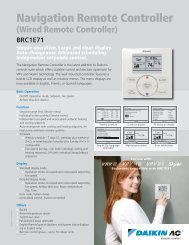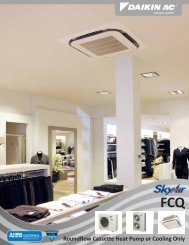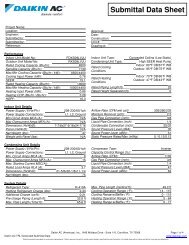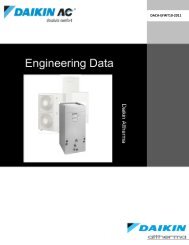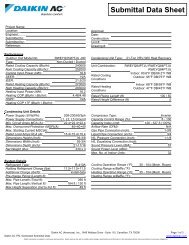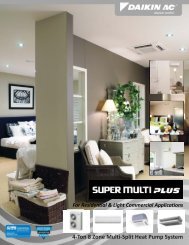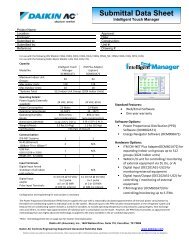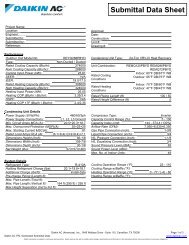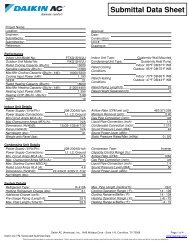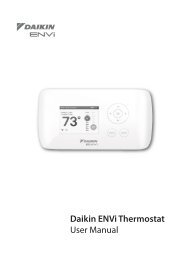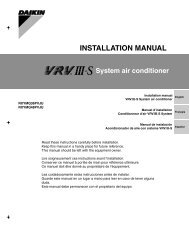INSTALLATION MANUAL - Daikin AC
INSTALLATION MANUAL - Daikin AC
INSTALLATION MANUAL - Daikin AC
Create successful ePaper yourself
Turn your PDF publications into a flip-book with our unique Google optimized e-Paper software.
Leak test1 Vacuum leak test1.1 Fully open the gauge manifold’s low-pressure valve (Lo)and completely close its high-pressure valve (Hi). The highpressuresubsequently requires no operation.1.2 Evacuate the system from the gas piping to –14.6 psi[–100.7 kPa (5 Torr, –755 mm Hg)].1.3 Once reached, close the gauge manifold’s low-pressurevalve (Lo), turn off the vacuum pump and check that thepressure does not rise for about 4-5 minutes.1.4 Should the pressure rise, the system may either containmoisture (see vacuum drying below) or have leaks.2 Pressure leak test2.1 Break the vacuum by pressurizing with nitrogen gas to aminimum gauge pressure of 29 psi [0.2 MPa (2 bar)].Never set the gauge pressure higher than the maximumoperation pressure of the unit, i.e. 605 psi [4.17 MPa(41.7 bar)].2.2 Test for leaks by applying a bubble test solution to all pipingconnections.NOTE2.3 Discharge all nitrogen gas.Vacuum dryingMake sure to use a recommended bubbletest solution from your wholesaler.Do not use soap water, which may causecracking of flare nuts (soap water maycontain salt, which absorbs moisture that willfreeze when the piping gets cold), and/orlead to corrosion of flared joints (soap watermay contain ammonia which causes acorrosive effect between the brass flare nutand the copper flare).To remove all moisture from the system, proceed as follows:1 Evacuate the system for at least 2 hours to a target vacuum of–14.6 psi [–100.7 kPa (5 Torr, –755 mm Hg)].2 Check that, with the vacuum pump turned off, the target vacuumis maintained for at least 1 hour.3 Should you fail to reach the target vacuum within 2 hours ormaintain the vacuum for 1 hour, the system may contain toomuch moisture.10.3. Pipe insulationSelection of heat insulation materialsWhen using commercial copper pipes and fittings, observe thefollowing:■ Insulation material: polyethylene foamHeat transfer rate: 0.285~0.361 BTU.inch/h.ft 2 .°F (0.041~0.052W/m•K)Refrigerant gas pipe's surface temperature reaches 230°F(110°C) max.Choose heat insulation materials that will withstand thistemperature.■■■NOTEBe sure to insulate both the gas and liquid piping and to provideinsulation dimensions as below.If the temperature is higher than 86°F (30°C) and the humidity ishigher than RH 80%, then the thickness of the sealing materialsshould be at least 0.79 inch (20 mm) in order to avoidcondensation on the surface of the sealing.165Any exposed piping may cause condensation or brunsif touched.Pipe insulationConnection pipe Inner diameter Thickness1/4 inch(Ø6.4 mm)5/8 inch(Ø15.9 mm)20.31~0.39 inch(8~10 mm)0.63~0.79 inch(16~20 mm)34Use separate thermal insulation pipes for gas and liquidrefrigerant pipes.11. CHARGING REFRIGERANT1 Gas pipe≥0.39 inch(10 mm)≥0.51 inch(13 mm)2 Conduit includinginterunit wiring3 Liquid pipe4 Liquid pipe insulation5 Finishing tape6 Gas pipe insulation4 In that case, break the vacuum by pressurizing with nitrogen gasto a gauge pressure of 7.25 psi [0.05 MPa (0.5 bar)] and repeatsteps 1 to 3 until all moisture has been removed.5 The stop valves can now be opened, and/or additionalrefrigerant can be charged (see "11.1. Additional refrigerantcharging" on page 11).NOTEAfter opening the stop valve, it is possible that thepressure in the refrigerant piping does not rise. Thismight be caused by e.g. the closed state of theexpansion valve in the outdoor unit circuit, but does notpresent any problem for correct operation of the unit.■■■■■■■DANGER: ELECTRICAL SHOCKSee "4. General safety precautions" on page 3.Refrigerant cannot be charged until field wiring has beencompleted.Refrigerant may only be charged after performing the leak testand the vacuum drying.When charging a system, care shall be taken that its maximumpermissible charge is never exceeded, in view of the danger ofliquid hammer.Charging with an unsuitable substance may cause explosionsand accidents, so always ensure that the appropriate refrigerantR410A is charged.Refrigerant containers shall be opened slowly.Always use protective gloves and protect your eyes whencharging refrigerant.When the refrigerant system is to be opened, refrigerant mustbe treated according to the applicable legislation.ERLQ018~030BAVJUOutdoor unit for air to water heat pump4PW62590-1 – 07.2010Installation manual10




